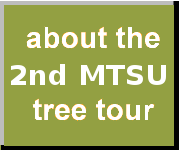
|

|

|

|
An individual instance of Diospyros virginiana (common persimmon)
Permanent unique identifier for this particular organism:
http://bioimages.vanderbilt.edu/mtsu/30
Notes:
Description
General: Ebony family (Ebenaceae). Native trees growing 5-12 (-21) meters tall; mature bark dark-gray, thick and blocky. Leaves are deciduous, simple, alternate, and ovate to elliptic or oblong with smooth edges, 3.5-8 cm long, with an acuminate apex and rounded base, the lower surface usually lighter-colored, especially on young leaves. Flowers are either male (staminate) or female (pistillate), borne on separate trees (the species dioecious) on shoots of the current year after leafing; pistillate flowers solitary, sessile or short-stalked, bell-shaped, ca. 2 cm long, the corolla creamy to greenish-yellow, fragrant, usually with 4 thick, recurved lobes; staminate flowers in 2-3-flowered clusters, tubular, 8-13 mm long, greenish-yellow. Fruit is a berry 2-5 cm wide, greenish to yellowish with highly astringent pulp before ripening, turning yellowish-orange to reddish-orange and sweet in the fall, each fruit with 18 flat seeds. The common name, persimmon, is the Native American word for the fruit.
Uses
Common persimmon is sometimes used as an ornamental for its hardiness, adaptability to a wide range of soils and climates, and immunity from disease and insects. Moist, well-drained soils provide best conditions but the plant will tolerate hot, dry, poor soils, including various city conditions. The species is rarely sold commercially, however. The leaves are glossy and leathery and may be yellow or reddish-purple in the fall. Several cultivars have been selected primarily for fruit color, taste, size, and early maturation; several are seedless. Budded or grafted trees are a sure way of getting a desired type. Common persimmon sends down a deep taproot, which makes it a good species for erosion control but makes it difficult to transplant.
The wood of common persimmon is hard, smooth, and even textured. The hardness and shock resistance make it ideal for textile shuttles and heads for driver golf clubs. The heartwood is used for veneer and specialty items, but most of commercially used persimmon is reported to consist of sapwood.
Unripe fruit and inner bark have been used in the treatment of fever, diarrhea, and hemorrhage. The fruits are used in puddings, cookies, cakes, custard, and sherbet; the dried, roasted, ground seeds have been used as a substitute for coffee. Flowers produce nectar significant for bees in honey production. Leaves and twigs of common persimmon are eaten in fall and winter by white-tailed deer. The fruit is eaten by squirrel, fox, skunk, deer, bear, coyote, raccoon, opossum, and various birds, including quail, wild turkey, cedar waxwing, and catbird.
Distribution
It is primarily a species of the east-central and southeastern U.S., with the southeast corner of its range in Texas, reaching northeast to New York and southern Connecticut, westward through southern Ohio, Indiana, and Illinois to Missouri and southeastern Kansas. It does not grow in the main range of the Appalachian Mountains nor in much of the oak-hickory forest of the Allegheny Plateau.
Establishment
Fruit may be produced by 10-year-old trees but optimum fruit-bearing age is 25-50 years. Good fruit crops are borne every 2 years. Seeds are dispersed by birds and animals and by overflow water in bottomlands. Persimmon is slow growing and usually does not make a large tree, although it may reach 21-24 meters tall on optimal sites. Trees have been reported to reach 150 years of age. The persimmon can form thickets from root suckers and collar sprouts.
References
Guy, N., & Moore, L., (2006). Plant guide for common persimmon (diospyros virginiana L.). Retrieved from http://plants.usda.gov/java/factSheet

|

|
|
Load database and switch to thumbnail view
Use this stable URL to link to this page:
http://bioimages.vanderbilt.edu/mtsu/30.htm
This particular organism is believed to have managed means of establishment.
This organismal entity has the scope: multicellular organism.
Identifications:
Diospyros virginiana
L.
sec. Tennessee Flora 2014
common name: common persimmon
family: Ebenaceae
Identified 2016-03-13 by Patrick Phoebus
Location:
Alma Mater Dr, Rutledge Hall, Rutherford County, Tennessee, US
Click on these geocoordinates to load a map showing the location: 35.8488°, -86.3701°
Coordinate uncertainty about: 10 m.
Altitude: 189 m.
Location calculated as average of its images' coordinates.
Occurrences were recorded for this particular organism on the following dates:
2016-03-13
2016-04-27
The following images document this particular organism.
Click on a thumbnail to view the image and its metadata. Load database and enable navigation by taxon and organism.
| Image | View |
|
|
whole tree (or vine) - general |
|
|
whole tree (or vine) - winter |
|
|
whole tree (or vine) - winter |
|
|
bark - unspecified |
|
|
bark - of a large tree |
|
|
bark - of a large tree |